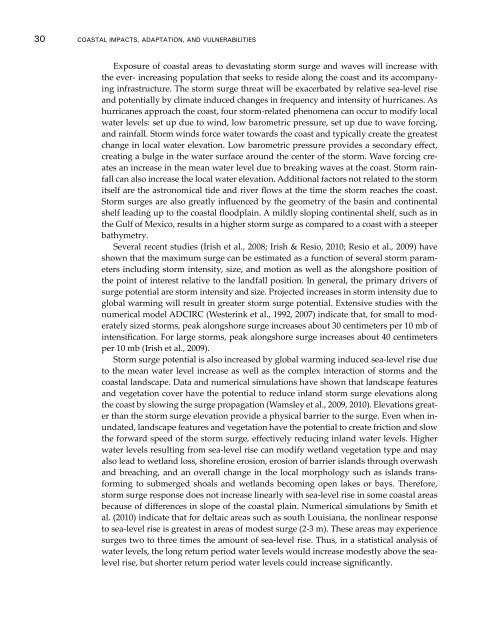Coastal Impacts, Adaptation, and Vulnerabilities - Climate ...
Coastal Impacts, Adaptation, and Vulnerabilities - Climate ...
Coastal Impacts, Adaptation, and Vulnerabilities - Climate ...
Create successful ePaper yourself
Turn your PDF publications into a flip-book with our unique Google optimized e-Paper software.
30 <strong>Coastal</strong> <strong>Impacts</strong>, <strong>Adaptation</strong>, <strong>and</strong> <strong>Vulnerabilities</strong>Exposure of coastal areas to devastating storm surge <strong>and</strong> waves will increase withthe ever- increasing population that seeks to reside along the coast <strong>and</strong> its accompanyinginfrastructure. The storm surge threat will be exacerbated by relative sea-level rise<strong>and</strong> potentially by climate induced changes in frequency <strong>and</strong> intensity of hurricanes. Ashurricanes approach the coast, four storm-related phenomena can occur to modify localwater levels: set up due to wind, low barometric pressure, set up due to wave forcing,<strong>and</strong> rainfall. Storm winds force water towards the coast <strong>and</strong> typically create the greatestchange in local water elevation. Low barometric pressure provides a secondary effect,creating a bulge in the water surface around the center of the storm. Wave forcing createsan increase in the mean water level due to breaking waves at the coast. Storm rainfallcan also increase the local water elevation. Additional factors not related to the stormitself are the astronomical tide <strong>and</strong> river flows at the time the storm reaches the coast.Storm surges are also greatly influenced by the geometry of the basin <strong>and</strong> continentalshelf leading up to the coastal floodplain. A mildly sloping continental shelf, such as inthe Gulf of Mexico, results in a higher storm surge as compared to a coast with a steeperbathymetry.Several recent studies (Irish et al., 2008; Irish & Resio, 2010; Resio et al., 2009) haveshown that the maximum surge can be estimated as a function of several storm parametersincluding storm intensity, size, <strong>and</strong> motion as well as the alongshore position ofthe point of interest relative to the l<strong>and</strong>fall position. In general, the primary drivers ofsurge potential are storm intensity <strong>and</strong> size. Projected increases in storm intensity due toglobal warming will result in greater storm surge potential. Extensive studies with thenumerical model ADCIRC (Westerink et al., 1992, 2007) indicate that, for small to moderatelysized storms, peak alongshore surge increases about 30 centimeters per 10 mb ofintensification. For large storms, peak alongshore surge increases about 40 centimetersper 10 mb (Irish et al., 2009).Storm surge potential is also increased by global warming induced sea-level rise dueto the mean water level increase as well as the complex interaction of storms <strong>and</strong> thecoastal l<strong>and</strong>scape. Data <strong>and</strong> numerical simulations have shown that l<strong>and</strong>scape features<strong>and</strong> vegetation cover have the potential to reduce inl<strong>and</strong> storm surge elevations alongthe coast by slowing the surge propagation (Wamsley et al., 2009, 2010). Elevations greaterthan the storm surge elevation provide a physical barrier to the surge. Even when inundated,l<strong>and</strong>scape features <strong>and</strong> vegetation have the potential to create friction <strong>and</strong> slowthe forward speed of the storm surge, effectively reducing inl<strong>and</strong> water levels. Higherwater levels resulting from sea-level rise can modify wetl<strong>and</strong> vegetation type <strong>and</strong> mayalso lead to wetl<strong>and</strong> loss, shoreline erosion, erosion of barrier isl<strong>and</strong>s through overwash<strong>and</strong> breaching, <strong>and</strong> an overall change in the local morphology such as isl<strong>and</strong>s transformingto submerged shoals <strong>and</strong> wetl<strong>and</strong>s becoming open lakes or bays. Therefore,storm surge response does not increase linearly with sea-level rise in some coastal areasbecause of differences in slope of the coastal plain. Numerical simulations by Smith etal. (2010) indicate that for deltaic areas such as south Louisiana, the nonlinear responseto sea-level rise is greatest in areas of modest surge (2-3 m). These areas may experiencesurges two to three times the amount of sea-level rise. Thus, in a statistical analysis ofwater levels, the long return period water levels would increase modestly above the sealevelrise, but shorter return period water levels could increase significantly.
















